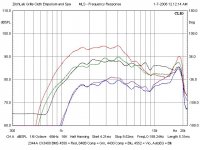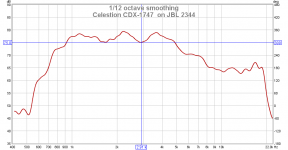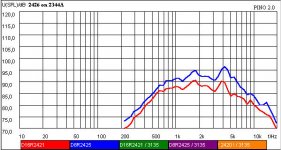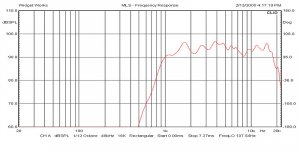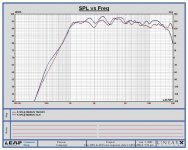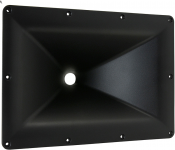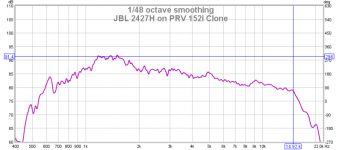(*) Incidentally, electrical damping also determines low frequency extension, so if you actually want bass out of your woofer, you can't push electrical damping too high...
For the JBL 2235H, we have Fs/Qes = 20/0.28 = 71
For the Celestion TF1525, we have Fs/Qes = 47/0.66 = 71
Lo and behold, they are equivalent, in terms of electrical damping!
You are correct but that's irrelevant unfortunately. As you surely know, the Thiele/Small parameters describe the small signal behaviour on and around the resonance frequency or, generally speaking, in the bass. Well, we are not talking about the bass here, we are talking about the midrange and what's important for the reproduction there. Since the resonance of the drivers is ~4 octaves lower, the Q-Factor at the resonance is not relevant at that frequencies anymore. I apologize because I made a short cut and did not calculate the motor force at higher frequencies and just compared the BL and the Mms. I've come to the conclusion we can agree that the Celestion is not worse here than the JBL, can we?
I hope we can agree on, that - in general - a stronger motor can compensate a higher moving mass but that got limits because of the possible maximum magnet strength (coupled with size) and the higher losses of stiffer suspension and more rugged surround.
Inductance is irrelevant when Woofers are used as intended, i.e. for low frequencies, since there will typically be much larger inductors in series.
Well, they are here used also in the midrange, that's why we are discussing it, isn't it? Ofcourse it is added for the complete filter but we are talking about what qualifies a driver for midrange use and what qualities are important there. And here the inductance of the voice coil actually does matter, quite a lot actually, I don't go into that deeper, I think you got the point. But to include the crossover inductance here is completely wrong because that got nothing to do with the motor and changes for every box anyway let alone speakers which are crossed over active and you'd have to include the serial resistance of the crossover in such a case anyway, not just the inductance.
As to higher mechanical losses, I agree these are important in determining a Woofer's mechanical damping, and hence its ability to reproduce micro-dynamics and detail at low volumes (the lower mechanical damping, the better).
However, mechanical damping is actually measured as:
Rms/Mms = 2*Pi*(Fs/Qms)
For the JBL 2235H, we have Fs/Qms = 20/2.5 = 8.0
For the Celestion TF1525, we have Fs/Qms = 47/5.9 = 8.0
What?! They are actually equivalent in terms of mechanical damping too!
No, that's wrong. You can only calculate the Qms, not actually measure it. The calculation does not show the complete truth either because of the influence of a conductive coil former (-> eddy current losses), which can't be separated from the real mechanical losses. In this regard the JBL could have a slight advantage because its got a conductive VC former (aluminium) and the celestion does not. The JBL got an aluminum Flux Stabilizing Ring (that's what JBL calls it) over the pole core, which compensates for that, so with that into the calculation, it is probably pretty even. I think this stabilizing ring is what you thought was the adde mass ring but it's on the pole core, not on the voice coil.
I know, it's not the point that you can't directly measure it. But that's only the damping at the Fs, with the changed impedance in the midrange it differs by a huge margin. But I want to thank you for the calculation which shows the Celestion does not have a big deficite or less control/damping in the bass.
And, incidentally, neither is particularly good in this regard.
That is ofcourse true. While I can see why a budget driver like the TF1525 isn't that all exciting here, I have to ask myself again why (or if) the JBL is worth that much more. I honestly do not want to drag down the JBL but the price tag is much too steep for me to justify the expense. If you want to know if the Celestion is good in the midrange, look at the measurements, they are excellent and exceptionally clean. I haven't found these measurements for the JBL but I've seen them before and they are ..different.
The downside is, the celestion doesn't go as deep as the JBL, got a lower max spl (well, I can live with over 120dB maximum at home
..back to topic..
@Patrick Bateman: Did you do any simulations of these horns? Or frequency ranges? If so, could you please post them?
In this case my Beymas with a Qms of 21 and an fs of 42 Hz must be king ! Although I doubt that Qms value to be correct.
That value would be a world record
To stay on topic: I guess it is actually the low frequencies where the 2230 monitor sounds nice and much less the mid/high part.
I agree on that, the low end is indeed very impressive, especally if you consider when these speakers were built. I don't plan it that way but if I would be disappointed by the celestions in the bass, I would just add my subwoofers.
I have a pair of original 2344 Horns with 2424 drivers and I can say that a more modern combination with a Failtal HF146 on a 18S XT1464 waveguide sounds much cleaner than the old JBL combination. The cabinets with the JBL drivers are currently used as stands for the ones with the Faital/18s/Beyma combination.
The biradial horns are what makes most of the character of these JBL monitor speakers, to me at least. And the dispersion is wide and quite good controlled. Have you tried the biradial horns with the Faital or other drivers?
In this case my Beymas with a Qms of 21 and an fs of 42 Hz must be king ! Although I doubt that Qms value to be correct.
To stay on topic: I guess it is actually the low frequencies where the 2230 monitor sounds nice and much less the mid/high part. I have a pair of original 2344 Horns with 2424 drivers and I can say that a more modern combination with a Failtal HF146 on a 18S XT1464 waveguide sounds much cleaner than the old JBL combination. The cabinets with the JBL drivers are currently used as stands for the ones with the Faital/18s/Beyma combination.
Regards
Charles
Keep in mind that having a loudspeaker in a room with another loudspeaker will color the sound. This is because the unpowered speaker will behave as a passive radiator.
Will it be audible? Who knows? But it's something to consider.
I made a short cut and did not calculate the motor force at higher frequencies and just compared the BL and the Mms.
Are you suggesting that the motor strength is different at mid frequencies than at resonance? Below where the inductance is significant.
And why if we add mass to the cone do we have to stiffen the suspension? Just let the resonance go down.
... Do you have any information about the winding height and pole plate thickness?...
Coil height of the 2235 is 0.750" Top plate thickness is 0.280"
...
The 2235h does not have a ring to add mass in the recone kit - which would be required to be included..
Yes it does have a mass ring and they are included in the factory C8R2234 cone kits. It is bonded to the top of the voice coil former after the cone is set and before the dust cap is installed. If you leave the mass ring out you have a 2234 as used in the 4435 monitor.
Barry.
...To stay on topic: I guess it is actually the low frequencies where the 2230 monitor sounds nice and much less the mid/high part. I have a pair of original 2344 Horns with 2424 drivers and I can say that a more modern combination with a Failtal HF146 on a 18S XT1464 waveguide sounds much cleaner than the old JBL combination....
Regards
Charles
No argument from me but,,,
The 2344/2421 or 2425 horn driver set as used in the 4430-4435 has a fairly sophisticated crossover/filter set. Most of the DIY implementations I have heard don't get nearly all there is to get out of these.
Listening to 4435's as I type this
Barry.
You can only calculate the Qms, not actually measure it.
huh?
Keep in mind that having a loudspeaker in a room with another loudspeaker will color the sound. This is because the unpowered speaker will behave as a passive radiator.
Will it be audible? Who knows? But it's something to consider.
I actually know. But I needed something that is sturdy enough to get those beasts above ground and the horn at ear Level - and these came handy.

The biradial horns are what makes most of the character of these JBL monitor speakers, to me at least. And the dispersion is wide and quite good controlled. Have you tried the biradial horns with the Faital or other drivers?
Yes the dispersion of these is definitley more adapted to usual home listening situations than the Eighteensound waveguide. The smaller Faital HF10AK would probably make a nice combination with the 2344.
The 2344/2421 or 2425 horn driver set as used in the 4430-4435 has a fairly sophisticated crossover/filter set. Most of the DIY implementations I have heard don't get nearly all there is to get out of these.
Listening to 4435's as I type this
When I compare my aforementioned newer horns with the 2344 combo then the newer one sounds less coloured out of the box. To get them reasonably flat less EQing is needed for the newer one. I am not talking about the CD EQing on top but of all the wiggles. When we look at the datasheet of the 4430/4425 monitors one can clearly see that their response below 1 kHz is much smoother than above. That said they are of course better than many newer speakers and I would take a pair of these if I could grab them for a reasonable price and I'd like to congratulate you for these. The fact that I will most probably keep the JBL combo although it is seldom used anymore speaks for itself.
The first time I heard the entry of the wind instruments on the title track of "Children of Sanchez" throug the 2344/2426 I was literally blown away. That is an experience that you can't get from the usual cone and dome setups. But my experiece tells me that more modern horns give smoother sound. I have a D2 on a PT waveguide and this one is even much smoother out of the box than the 18Sound/Faital combo apart from the stronger CD drop of the JBL combo but that is not an issue. I am looking forward to listening to this one in a three way speaker soon.
Regards
Charles
That experience is mine as well, a few horns anyway....But my experiece tells me that more modern horns give smoother sound...
Regards
Charles
Barry.
An externally hosted image should be here but it was not working when we last tested it.
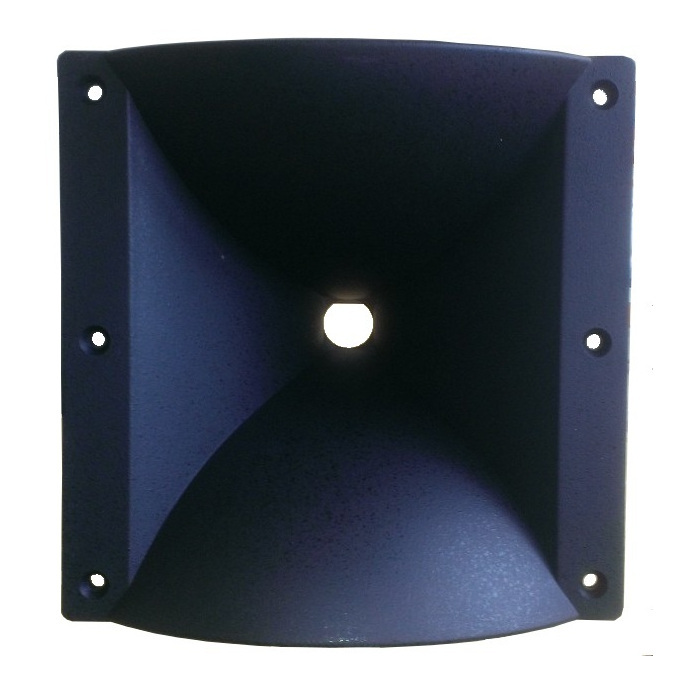
PH-230 from Bluearan
Last edited:
Decades of research have shown that sharp edges on horns create diffraction and should be avoided. This means no diffraction slot, or sharp edge terminations. The sonic effects of doing this are quite impressive. There is a lot of information on this topic here at DIY. See "Geddes on Waveguides" for example.
As Marco said, it's the 2344 that's the problem ( as far as having linear response goes ) / though the ( BMS ) 4550 does fare better in its mid-band response ( as far as diffractive suck-outs go ).
Here's an ancient trace ( from Zilch ) that shows what a challenge the 4550/2344 combo would be ( to design for ) .
Of course, one can actively EQ almost anything flat / but creating a workable passive network to fix what's seen in the red trace below would test the best network designer.
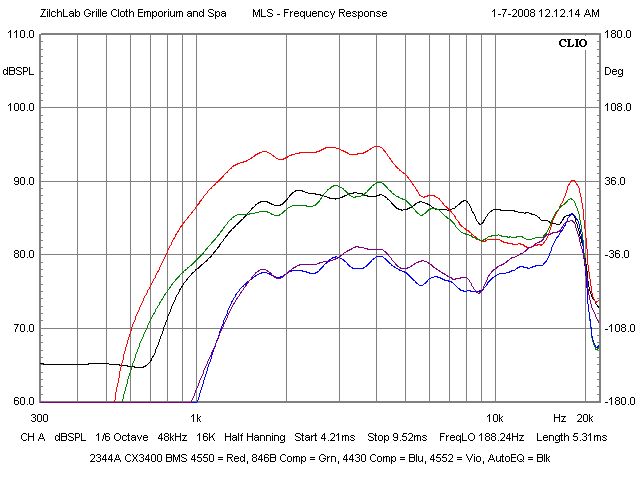
The following Celestion driver doesn't fare much better ( IMO ).
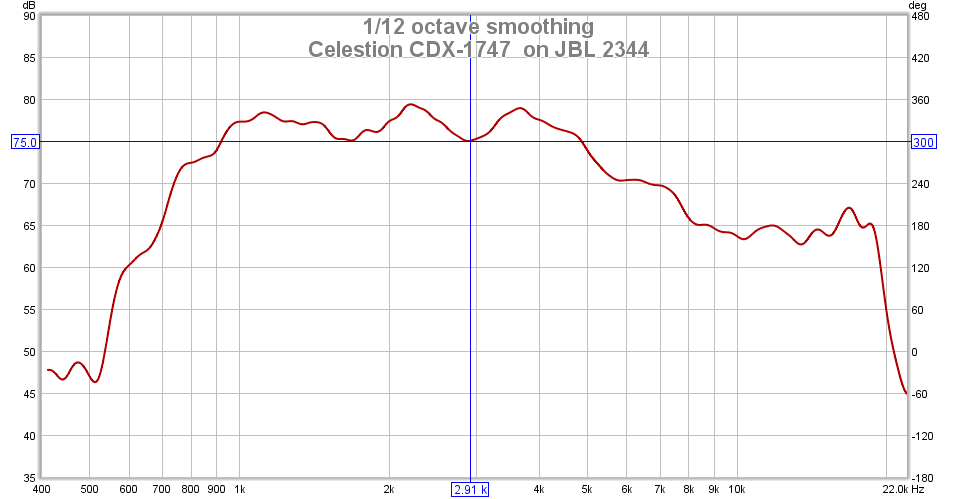
Mind-you, I suppose those ( above ) are still better ( 1-5K wise ) than the raw response of this 2425 on the 2344.
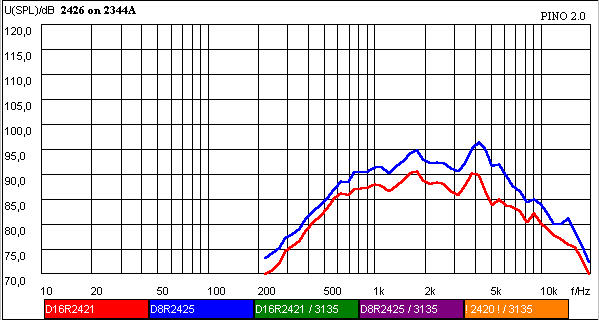
With the compensation filter in place, response will eventually look like this;
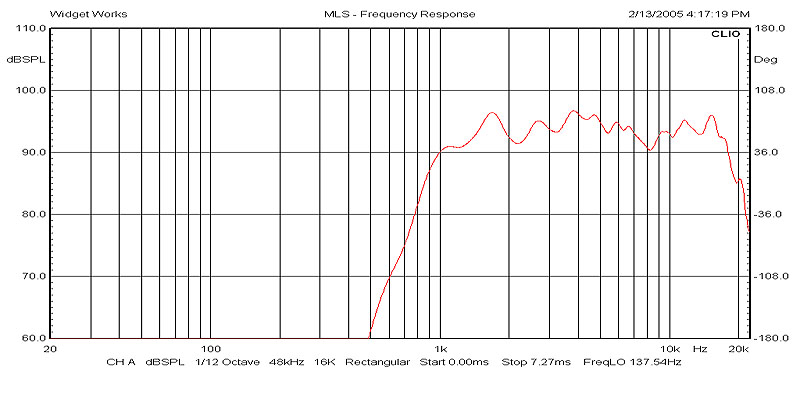
The above trace ( intriguing to me at least ) is flat enough to support the love-in going on ( over at AudioKarma ) over the 4435 speaker.
Some new 4435 devotees are really driving quite a renaissance over its capabilities.
The TAD 2001 is not immune to the negative effects ( on FR ) of this horns builtin diffraction problems.


Here's an ancient trace ( from Zilch ) that shows what a challenge the 4550/2344 combo would be ( to design for ) .
Of course, one can actively EQ almost anything flat / but creating a workable passive network to fix what's seen in the red trace below would test the best network designer.
The following Celestion driver doesn't fare much better ( IMO ).
Mind-you, I suppose those ( above ) are still better ( 1-5K wise ) than the raw response of this 2425 on the 2344.
With the compensation filter in place, response will eventually look like this;
The above trace ( intriguing to me at least ) is flat enough to support the love-in going on ( over at AudioKarma ) over the 4435 speaker.
Some new 4435 devotees are really driving quite a renaissance over its capabilities.
The TAD 2001 is not immune to the negative effects ( on FR ) of this horns builtin diffraction problems.
Attachments
wow, Earl - impressive investigation
Thanks for the moment, I need to study more deeply
Chris
PS: so bottom line: you would recommend to use a different horn and a different driver... 4435/30 is not a great speaker respectively can be done better?
This is a good waveguide ( previously mentioned by Patrick ) .
PRV made a clone for a while.
Both ( the QSC 152i & the PRV clone ) are NLA unfortunately .
I'd seriously consider this w-guide driven by a JBL 2425/6/7h.
Response seen below ( 1/2 meter testing distance ).
This is a well behaved ( raw ) response and is easily compensated for ( within a passive crossover ).
Unfortunately, these wave guides are no longer sold .
Maybe Patricks version will work out for you.
PS; the SEOS 18 would be worth a look at ( they are available over there in Europe ).
Attachments
Last edited:
The PT waveguides seem to perform nicely as well:
JBL D2430K mounting issues
So does the Eighteensound XT1086 (although it won'z go down to 1 kHz):
2-Way DiY Hifi speakers eighteensound
Regards
Charles
JBL D2430K mounting issues
So does the Eighteensound XT1086 (although it won'z go down to 1 kHz):
2-Way DiY Hifi speakers eighteensound
Regards
Charles
- Home
- Loudspeakers
- Multi-Way
- How to Make a New Wave Biradial Horn
